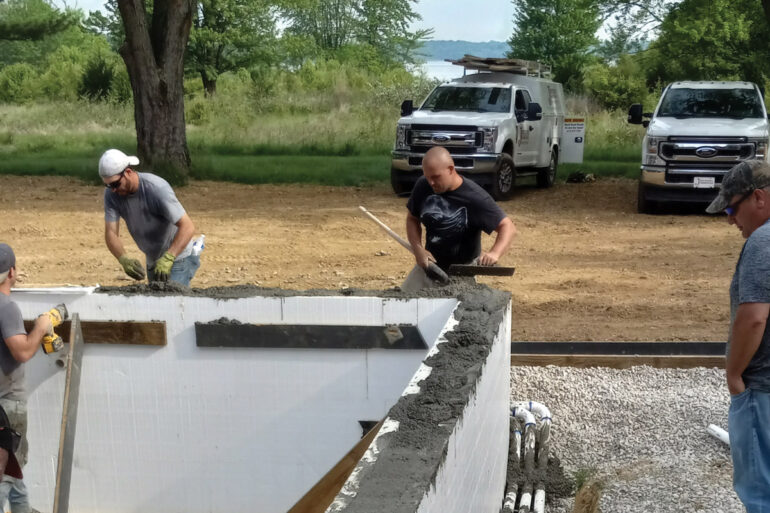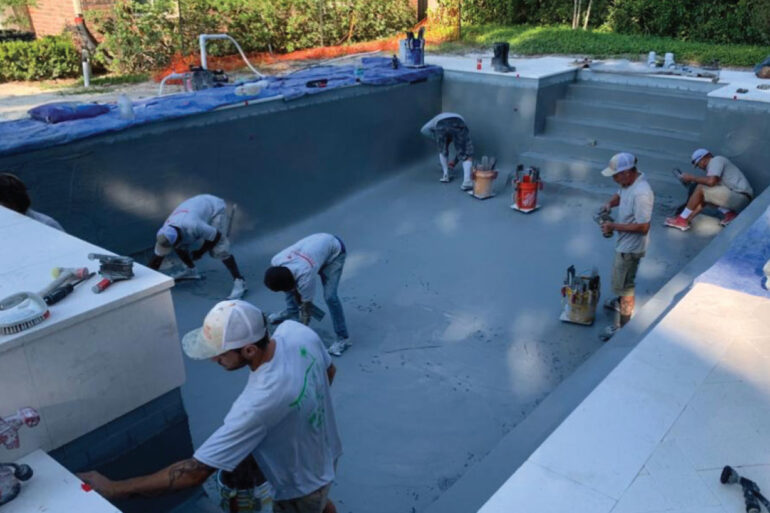Trowel and Error

Pool plaster has a two-part role: to improve a pool’s appearance and to serve as a line of defense. A well-maintained plaster surface should last 15 to 20 years, but over time, that surface can wear down. Temperature variations, exposure to elements, improper water balance and continuous exposure to chlorine all take their toll. If the plaster exists on top of a poor build, however, even the best maintenance efforts won’t keep the pool in shape.
“The plaster company cannot fix the pool builder’s mistakes,” says Bill Drakeley, founder of Drakeley Pool Company in Bethlehem, Connecticut.
When working with a poor build, plaster specialists face an uphill battle, Drakeley says. “It’s just going to be a mirroring effect through the pool concrete,” he explains. “You don’t plaster the pool to hide the problems. You fix the problems before you plaster the pool.”
Drakeley believes a good pool builder should not only know their product, right down to the chemistry of the concrete, but also how to construct a pool that is watertight. The key, he says, is following the American Concrete Institute code. “I confirm those specifications before the plaster guy gets there,” Drakeley says.
Stephanie Poppert, project coordinator for Poolscape Unlimited Inc. in Lakeside, California, knows a low-quality build when she sees one. Common examples of a poor build include not leaving enough room to install the pebble, so the tile is flush with the gunite, or when a builder leaves a surface too smooth, which she says makes it difficult for the bond coat to adhere.
“If the surfaces are too smooth, the pebble won’t grip to it,” Poppert explains. “I would say new builders need to know what to look out for.”
Another way Poppert says builders can help the plasterers get in and out of a job faster is cleaning up after themselves. “[It] would definitely help out if the pool is cleaned of all the debris and the mess that installing tile, coping and all that stuff creates,” Poppert says. “I would appreciate if the pool equipment was set and programmed and all extra fittings, like umbrella sleeves or jet covers, are on-site.”
Rob Romano, general manager for David Cooke Plaster Co. in South Windsor, Connecticut, believes that strong communication and cooperation between builders and plasterers is paramount to a successful installation. “A good applicator and good builder who work well together is a winning combination,” Romano says. “Communication is key from both parties. The builder needs to know what the applicator expects to ensure a proper installation.”
One way a builder can make a plasterer’s job easier is by stopping short of the wall when running tiles on steps, otherwise: “We will bury part of that tile every time,” Romano explains. With enough space, a plasterer can finish properly troweling, he says.
Like Poppert, a common issue Romano sees is improper placement of glass tiles to accommodate pebble finishes. “Some of the pebbles could be as thick as the tile,” Romano explains. “Which is why I suggest installing any tile a half-inch off the pool wall or floor.”
These may sound like minor issues, but Romano says that such oversights can lead to other problems down the road. A bad bond coat, for example, can lead to plaster that looks like it is blistering, peeling, bubbling or even changing colors. Any of these issues can leave a homeowner feeling cheated, damage the reputations of both the plasterer and the builder and even lead to potential lawsuits.
Romano recalls countless times in which a bad bond coat has made his job more difficult, adding, “Sometimes we catch them, and when we do, we leave the job. No one wants to install over a bad bond coat and risk a delamination.”






